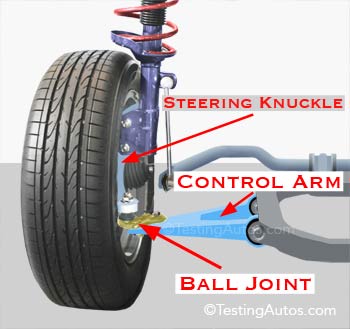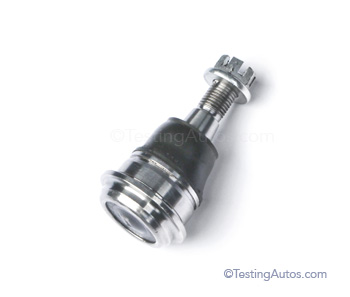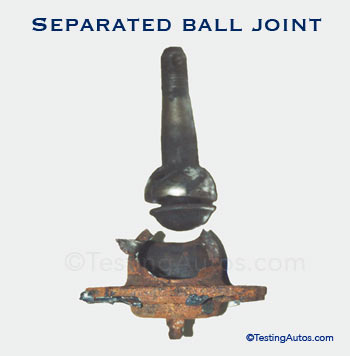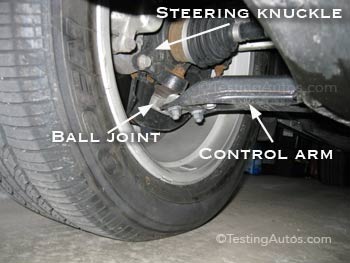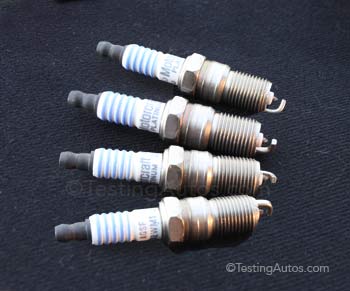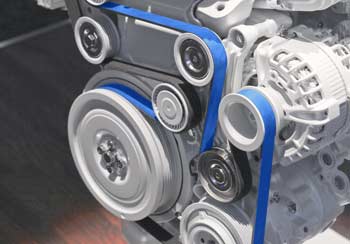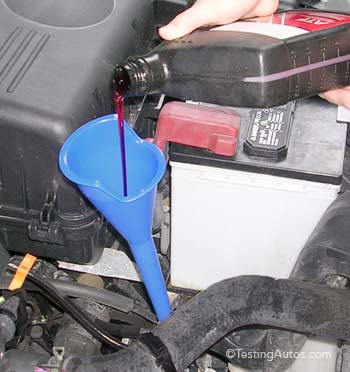When do the ball joints need to be replaced?
Your car has many components that are vital for safe driving, and a ball joint is one of them. A ball joint is a part of the front suspension. It connects the control arm to the part that holds the front wheel called a steering knuckle, see the illustration. The connection is flexible, so the front wheel can steer and move up and down. Modern cars have at least two ball joints in the front end; many trucks have four.In many cars, a ball joint is built into the control arm and is replaced as one unit. We covered control arms in this separate article: When do control arms need to be replaced? Here we will focus on the type of ball joint that comes as a separate part, like in these photos. What does it do and when should it be replaced?
A ball joint consists of a housing (socket) and a stud with a ball; it serves as a flexible joint. In some trucks, ball joints have grease fittings and need to be greased periodically. The majority of modern cars have non-serviceable ball joints that are greased at the factory and sealed with a rubber or polyurethane dust boot. When do ball joints need to be replaced? There is no mileage requirements. Ball joints need to be periodically inspected and replaced if worn. We have seen them last for over 160K miles, but potholes, speed bumps and road salt in winter months take their toll. If not caught in time, a badly worn ball joint can even separate while driving. If it separates, a vehicle will lose control. You might have seen an older car with one of the front wheels collapsed under the vehicle. See the photo of a separated ball joint below.
In some trucks, checking ball joints is not a quick task: load-carrying ball joints, for example, must be unloaded to check them. Mechanics have specific instructions from car manufacturers on how to inspect ball joints and when a ball joint is deemed to be bad.
For example, a ball joint is usually replaced if it has excessive play or if it's loose. It's also replaced if the dust boot is broken or torn. When a dust boot is damaged, grease can come out and water and dirt can get inside the ball joint. In either case, a ball joint won't last long. In some trucks, grease fittings serve as ball joint wear indicators. If a car has a bad ball joint, it's considered unsafe to drive.
It might also be a good idea to replace a ball joint as a precaution if it shows early signs of wear; for example, if it looks dry (lacks grease) or shows excessive rust damage. Corrosion damage is a major cause for ball joint failures. A ball joint that lacks grease may produce a creaking or squeaking noise when driving slowly over large bumps or when turning the steering wheel. Of course, there is a number of steering and suspension components that can produce a creaking noise; the source of the noise must be diagnosed properly.
What are the symptoms of a bad ball joint? A bad ball joint can cause a knocking or creaking noise coming from the front end when going over bumps. The steering and the whole front end may feel loose too, especially when going over bumps. In some vehicles, however, a bad ball joint will not produce any noticeable symptoms even if is bad. For this reason, it's important to have the vehicle inspected regularly to keep it safe.
If your car is out of warranty and it needs new ball joints, check with a local dealer and do some research. A number of car manufacturers issued recalls and service campaigns related to ball joints in the past.
If you have to replace ball joints, use good quality parts; it's an investment in your safety. We have seen cheap aftermarket ball joints failing within a year or two.
How much does it cost to replace a ball joint? Ball joints are not very expensive parts ($45-120 for one), so the majority of the repair cost is determined by labor charges. In some cars ball joints are bolted to the control arm or to the steering knuckle and are easy to replace. For example, the Toyota Highlander in this photo has one ball joint on each side in the front; it's bolted to the lower control arm. Replacing this type of ball joint in a repair shop would cost from $240 to $420.
In some cars and trucks, ball joints are riveted or threaded into the control arm. This type is bit more difficult to replace, and the repair will cost more.
In many cars, SUVs and pickup trucks, ball joints are press-fitted into the control arms or into the steering knuckles (spindles).
Advertisement
Do ball joints have to be replaced in pairs? No, it's not necessary, however, often when one ball joint is bad the other could be worn out too. In pickup trucks with double-arm front suspension, the upper and lower ball joints on one side are often replaced at the same time if the labor overlaps.
In some vehicles, the wheel alignment must be performed after replacing ball joints. The wheel alignment costs from $50 to $180.
Read Next:
When should struts and shock absorbers be replaced?
How often should the wheel alignment be done?
When do the control arms need to be replaced?
When do coil springs need replacing in a car?
When does the tie rod end need to be replaced?
When to replace sway bar links?
When Should Tires be Replaced in a Car?
When should struts and shock absorbers be replaced?
How often should the wheel alignment be done?
When do the control arms need to be replaced?
When do coil springs need replacing in a car?
When does the tie rod end need to be replaced?
When to replace sway bar links?
When Should Tires be Replaced in a Car?
